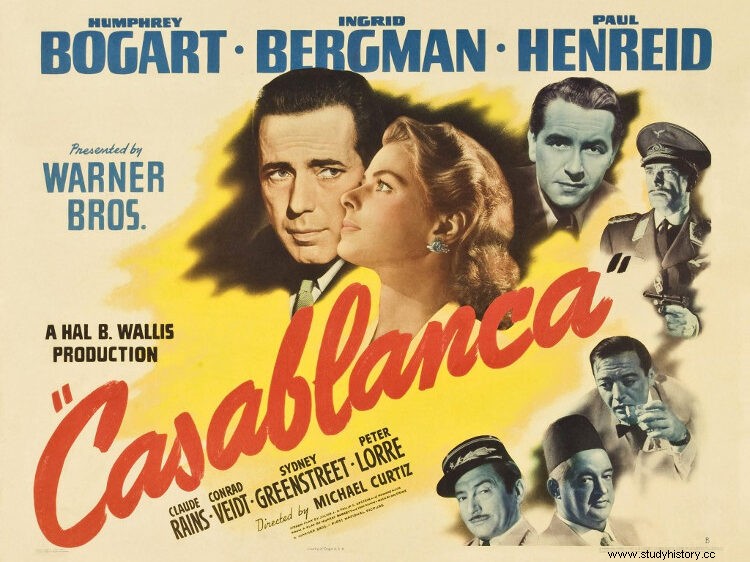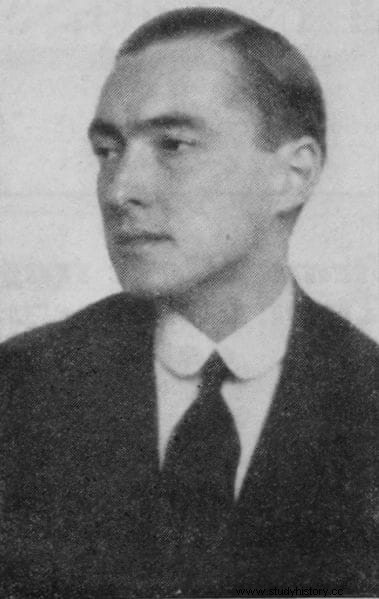One of the mythical films in the history of cinema is, without a doubt, Casablanca , winner of the Oscar in 1943. The story of the American Rick Blaine who during World War II runs a nightclub in the Moroccan city where the lives and destinies of an old lover, her husband, the local police chief and an officer intersect. of the Gestapo, among others, was based on a play entitled Everybody comes to Rick's that it never premiered and took place in Vienna; in it, Rick was a lawyer and had had a romantic relationship with Ilsa (Ingrid Bergman in the film) before she met her husband, Victor Lazslo. This, along with Sam, is one of the characters in the plot that was inspired by someone real:Richard von Coudenhove-Kalergi. Or so they say.
Victor Lazslo, played by Austrian actor Paul Henreid (later naturalized American), is a Czech Resistance hero whose wife thinks he has been killed in a concentration camp and consoles herself by falling in love with Rick in Paris. Then, learning that he is still alive, she runs to her husband's side, hastily abandoning her new love and leaving him marked forever by a cynical character that she tries to cope with by enlisting in the International Brigades to fight in the Spanish Civil War... They meet again in Casablanca. Ilsa appears there arm in arm with Lazslo, who, taking advantage of the fact that it is a city under the Vichy regime, has no qualms about provoking the Germans. The truth is that Lazslo's life does not have much to do with that of his alleged real model, beyond a certain physical resemblance and some specific situations.
His full name was Richard Nikolaus Eijiro, Count of Coudenhove-Kalergi, born in Tokyo in 1894 to the Austro-Hungarian aristocrat and diplomat of Greek descent Heinrich Coudenhove-Kalergi and a Japanese woman from a wealthy family named Mitsuko Aoyama; a whole international combination that, in a certain way, prefigured what would later be one of the great ideas proposed by his offspring, pan-Europeanism. But before that he received, together with his brother, a spartan education that included religion, languages, shooting practice and finally university education, since he received his doctorate in Philosophy in Vienna in 1917. By then he had already been married for two years to the actress Ida Roland, marriage that led to the rejection of her parents for her profession, because she was thirteen years older and for lack of fortune.

Despite his rancid ancestry, Richard had a conservative-liberal ideology, having opposed the traditional anti-Semitism typical of Germany at the time that his father represented at home (author of a book entitled Das Wesen des Antisemitismus , The essence of anti-Semitism), believing that both races and classes would disappear over time as prejudices were diluted. In 1921 he entered the Viennese masonic lodge Humanitas and the following year he founded, together with Archduke Otto of Habsburg-Lorraine (son of the last emperor of Austria), the Pan-European Union. Meant as a way to unite the continent and present a common defense against the growing power of revolutionary Russia, the seminal document was translated into numerous languages and attracted the attention of Max Warburg, a Jewish banker who offered to finance the movement. /P>
This allowed Richard to create the magazine Paneuropa in 1924 and, the following year, publish what would be his great doctrinal work: Kampf um Paneuropa (The fight for Paneuropa), which occupied three volumes. In 1926 the Austrian capital hosted the celebration of the first congress of the Pan-European Union, attended by two thousand delegates and some figures from the world of culture and science such as Albert Einstein, Thomas Mann or Sigmund Freud. Richard was elected president and the postulates approved were as revolutionary as they were utopian:a federally articulated United States of Europe in which capitalism and socialism would come together harmoniously and which would coexist with the other four major world forces, namely, the Commonwealth, a Union Pan-American, the USSR and a Pan-Asian Union.

The common language of that united Europe would be English - nationals apart - and the anthem is familiar to us because decades later it would become a reality:the Ode to Joy of Beethoven. The unprecedented proposal attracted some politicians such as the French Aristide Briand (who defended pan-Europeanism in a speech at the League of Nations in 1929), the Austrian Ignaz Seipel, the Italian Carlo Sforza or the German Hjalmar Schacht.
Others were skeptical and some unleashed the thunder box against, leading the singing voice of the latter Adolf Hitler. The future Führer dispatched himself at ease against his compatriot, accusing him of being controlled by Freemasonry (although in reality Richard had abandoned it in 1926) and abhorring cosmopolitanism, miscegenation and pacifism that would leave Europeans defenseless against US aggressiveness. .

Against the Nazis, Richard was forced to flee Austria when the Anchluss occurred in 1938. , the annexation of the country by Germany. He took refuge in France -where he was granted nationality, which he would keep forever as his own-, but when the Second World War broke out he had to pack his bags again and went to the US. For a time it was rumored that he had died, although in 1940 it became clear that it was a hoax when he began to launch proclamations in favor of the Allies, this episode being the point of greatest similarity with the character of Casablanca . For the rest, the Nazi regime had taken away his doctorate for being Jewish -he was not- and it would not be returned to him until 1955, but that did not prevent him from teaching history at New York University during the war.
In 1944 he published a new work, Crusade for Paneurope (Crusada por Paneuropa) that insisted on its idea as a common defense and that was seen favorably by William Joseph Donovan (creator of the OSS, US Office of Strategic Services, germ of the CIA) and Allen Dulles (future director of the agency ). Also by Roosevelt, Churchill and Truman, the latter praising him when peace finally came and supporting his efforts in building his dream, if not in full then at least in part. For this reason, between 1946 and 1947, a consultation was held on the matter among European parliamentarians, which resulted in the formation of the EPU (European Parliamentary Union), a private organization that was the first to propose the idea of a common market with a single currency.

In 1950 Richard received the first edition of the Charlemagne Prize, which has been awarded ever since to those who have contributed to European peace and development; It was very appropriate, since the winner had expressed more than once to claim a new version of that Frankish empire that made continental culture flourish. In fact, the fifties were very fruitful personally for him because he also forged closer ties with his motherland, Japan, where his works were translated and some politicians, such as Foreign Minister Morinosuke Kajima, embraced the idea Pan Asian Of course, he also suffered the death of his wife, although he would marry another two times.
In the following decade he continued to work on fostering the European community, advocating a customs union as a precursor to a monetary one. Richard came to see some partial forms of European union such as the CECA (European Coal and Steel Community, 1951), the CED (European Defense Community, 1952) or the EEC (European Economic Community, 1957), despite the fact that he stated certain reservations because they did not integrate the citizenry. What he could not attend was the birth of the European Union with capital letters because he died in the summer of 1972. The death was officially attributed to a stroke, although his secretary said that she had committed suicide. On his grave you can read the epitaph in French Pionnier des États-Unis d’Europe (Pioneer of the United States of Europe).
